FIM-92 Stinger
The FIM-92 Stinger is a man-portable air-defense system (MANPADS) that operates as an infrared homing surface-to-air missile (SAM). It can be adapted to fire from a wide variety of ground vehicles and helicopters (as an air-to-air missile). Developed in the United States, it entered service in 1981 and is used by the militaries of the United States and 29 other countries. It is principally manufactured by Raytheon Missile Systems and is produced under license by EADS in Germany and by ROKETSAN in Turkey, with 70,000 missiles produced.
| Stinger | |
|---|---|
_noBG.png) Dummy FIM-92 Stinger launcher. | |
| Type | Man-portable surface-to-air missile |
| Place of origin | United States |
| Service history | |
| In service | 1981–present |
| Used by | See Operators |
| Wars | Falklands War, Soviet–Afghan War, Iran–Iraq War, Angolan Civil War, Sri Lankan Civil War, Chadian–Libyan conflict, Tajikistani Civil War, Kargil War, Yugoslav Wars, Invasion of Grenada, Second Chechen War, War in Afghanistan, Iraq War, Syrian Civil War, Iraqi Civil War (2014–2017) |
| Production history | |
| Designer | General Dynamics |
| Designed | 1967 |
| Manufacturer | Raytheon Missile Systems |
| Unit cost | U.S.$38,000 |
| Produced | 1978–present |
| Variants | FIM-92A, FIM-92B, FIM-92C, FIM-92D, FIM-92G |
| Specifications (FIM-92 Stinger) | |
| Mass | 33.5 lb, 15.19 kg |
| Length | 59.8 in (1.52 m) |
| Diameter | 2.76 in (70.1mm) |
| Crew | 1 |
| Warhead | High explosive annular blast fragmentation |
| Warhead weight | 3 kg (6.6 lb) |
| Engine | Solid-fuel rocket motor |
Guidance system | Infrared homing |
Launch platform | MANPADS, M6 Linebacker, Multi-Mission Launcher, Eurocopter Tiger, AN/TWQ-1 Avenger, MQ-1 Predator, AH-64 Apache, T-129 ATAK |
Description
Light to carry and easy to operate, the FIM-92 Stinger is a passive surface-to-air missile that can be shoulder-fired by a single operator (although standard military procedure calls for two operators, team chief and gunner). The FIM-92B missile can also be fired from the M-1097 Avenger and the M6 Linebacker. The missile is also capable of being deployed from a Humvee Stinger rack, and can be used by airborne troops. A helicopter launched version exists called Air-to-Air Stinger (ATAS).
The missile is 5.0 ft (1.52 m) long and 2.8 in (70 mm) in diameter with 3.9 in (100 mm) fins. The missile itself weighs 22 lb (10.1 kg), while the missile with its launch tube and integral sight, fitted with a gripstock and IFF antenna, weighs approximately 34 lb (15.2 kg). It has an outward targeting range of up to 4,800 m and can engage low altitude enemy threats at up to 3,800 m. The Stinger is launched by a small ejection motor that pushes it a safe distance from the operator before engaging the main two-stage solid-fuel sustainer, which accelerates it to a maximum speed of Mach 2.54 (750 m/s). The warhead is a 6.6 lb (3 kg) penetrating hit-to-kill annular blast fragmentation type with an impact fuze and a self-destruct timer.
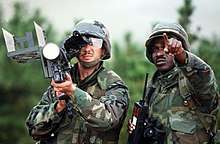
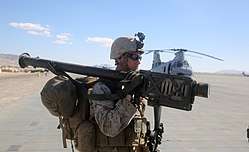
To fire the missile, a BCU (Battery Coolant Unit) is inserted into the gripstock. This device consists of a supply of liquid argon which is injected into the seeker to cool it to operating temperature, and a thermal battery which provides power for target acquisition: a single BCU provides power and coolant for roughly 45 seconds, after which another must be inserted if the missile has not been fired. The BCUs are somewhat sensitive to abuse, and have a limited shelf life due to the pressurised liquid argon leaking. The IFF system receives power from a rechargeable battery which is part of the IFF interrogator box which plugs into the base of the gripstock's pistol grip. Guidance to the target is initially through proportional navigation, then switches to another mode that directs the missile towards the target airframe instead of its exhaust plume.
There are three main variants in use: the Stinger basic, STINGER-Passive Optical Seeker Technique (POST), and STINGER-Reprogrammable Microprocessor (RMP). These correspond to the FIM-92A, FIM-92B, and FIM-92C and later variants respectively.
The POST has a dual-detector seeker: IR and UV. This allows it to distinguish targets from countermeasures much better than the Redeye and FIM-92A, which have IR-only. While modern flares can have an IR signature that is closely matched to the launching aircraft's engine exhaust, there is a readily distinguishable difference in UV signature between flares and jet engines.[1] The Stinger-RMP is so-called because of its ability to load a new set of software via ROM chip inserted in the grip at the depot. If this download to the missile fails during power-up, basic functionality runs off the on-board ROM. The four-processor RMP has 4 KB of RAM for each processor. Since the downloaded code runs from RAM, there is little space to spare, particularly for processors dedicated to seeker input processing and target analysis.
History
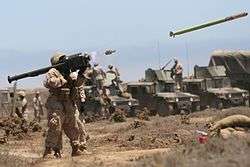
The missile began as a program by General Dynamics to produce an improved variant of their 1967 FIM-43 Redeye. Production of the Redeye ran from 1969 to 1982, with a total production of around 85,000 missiles.[2] The program was accepted for further development as Redeye II by the U.S. Army in 1971 and designated FIM-92; the Stinger appellation was chosen in 1972. Because of technical difficulties that dogged testing, the first shoulder launch was not until mid-1975. Production of the FIM-92A began in 1978. An improved Stinger with a new seeker, the FIM-92B, was produced from 1983 alongside the FIM-92A. Production of both the A and B types ended in 1987 with around 16,000 missiles produced.
The replacement FIM-92C began development in 1984, and production began in 1987. The first examples were delivered to front-line units in 1989. C-type missiles were fitted with a reprogrammable microprocessor, allowing for incremental firmware updates. Later missiles designated D received improvements to improve their ability to defeat countermeasures, and later upgrades to the D were designated G.
The FIM-92E or Block I was developed from 1992 and delivered from 1995 (certain sources state that the FIM-92D is also part of the Block I development). The main changes were again in the sensor and the software, improving the missile's performance against low-signature targets. A software upgrade in 2001 was designated F. Block II development began in 1996 using a new focal plane array sensor to improve the missile's effectiveness in "high clutter" environments and increase the engagement range to about 25,000 feet (7,600 m). Production was scheduled for 2004, but Jane's reports that this may be on hold.
Since 1984 the Stinger has been issued to many U.S. Navy warships for point defense, particularly in Middle Eastern waters, with a three-man team that can perform other duties when not conducting Stinger training or maintenance. Until it was decommissioned in September 1993, the U.S. Navy had at least one Stinger Gunnery Detachment attached to Beachmaster Unit Two in Little Creek Virginia. The sailors of this detachment would deploy to carrier battlegroups in teams of two to four sailors per ship as requested by Battle Group Commanders.
Variants
- FIM-92A, Stinger Basic: The basic model.[3]
- FIM-92B, Stinger POST: In this version, the infrared seeker head was replaced by a combined IR/UV seeker that utilized rosette scanning. This resulted in achieving significantly higher resistance to enemy countermeasures (flares) and natural disturbances. Production ran from 1981 to 1987; a total of 600 missiles were produced.[3]
- FIM-92C, Stinger RMP: The resistance to interference was increased again by adding more powerful digital computer components. Moreover, the software of the missile could now be reconfigured in a short time in order to respond quickly and efficiently to new types of countermeasures. Until 1991, some 20,000 units were produced for the U.S. Army alone.[3]
- FIM-92D: Various modifications were continued with this version in order to increase the resistance to interference.[3]
- FIM-92E: Stinger—RMP Block I: By adding a new rollover sensor and revised control software, the flight behavior was significantly improved. Additionally, the performance against small targets such as drones, cruise missiles and light reconnaissance helicopters was improved. The first deliveries began in 1995. Almost the entire stock of U.S. Stinger missiles was replaced by this version.[3]
- FIM-92F: A further improvement of the E version and the current production version.[3]
- FIM-92G: An unspecified upgrade for the D variant.[3]
- FIM-92H: Indicates a D variant that has been upgraded to the E standard.[3]
- Stinger—RMP Block II: This variant was a planned developed based on the E version. The improvements included an imaging infrared seeker head from the AIM-9X. With this modification, the detection distance and the resistance to jamming was to be greatly increased. Changes to the airframe would furthermore enable a significant increase in range. Although the missile reached the testing phase, the program was dropped in 2002 for budgetary reasons.[3]
- FIM-92J, Block 1 missile upgrade to replace aging components to extend service life an additional 10 years. Upgrades include a proximity fuse warhead section, equipped with a target detection device to increase effectiveness against unmanned aerial vehicles,[4][5] a new flight motor and gas generator cartridge, as well as new designs for the o-rings and integral desiccant cartridge.[6]
- FIM-92K, variant of FIM-92J designed to use a vehicle datalink rather than the missile's own seeker for targeting.[7]
- ADSM, Air Defense Suppression Missile: Cancelled experiment variant fitted with a passive radar seeker, designed to be used against radar wave transmitters.[8] The program began in FY 1983[9] and a final report was issued December 3rd 1986.[10]
Service
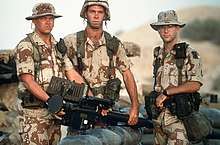
Falklands War
The Stinger's combat debut occurred during the Falklands War fought between the United Kingdom and Argentina. At the onset of the conflict soldiers of the British Army's Special Air Service had been clandestinely equipped with six missiles, although they had received little instruction in their use. The sole SAS trooper who had received training on the system, and was due to train other troops, was killed in a helicopter crash on 19 May.[11] Nonetheless, on 21 May 1982 an SAS soldier engaged and shot down an Argentine Pucará ground attack aircraft with a Stinger.[12] On 30 May, at about 11.00 a.m., an Aerospatiale SA-330 Puma helicopter was brought down by another missile, also fired by the SAS, in the vicinity of Mount Kent. Six National Gendarmerie Special Forces were killed and eight more wounded.[13] The main MANPADS used by both sides during the Falklands War was the Blowpipe missile.
Soviet War in Afghanistan
In late 1985, several groups, such as Free the Eagle, began arguing the CIA was not doing enough to support the Mujahideen in the Soviet–Afghan War. Michael Pillsbury, Vincent Cannistraro, and others put enormous bureaucratic pressure on the CIA to provide the Stinger to the rebels. The idea was controversial because up to that point, the CIA had been operating with the pretense that the United States was not involved in the war directly, for various reasons. All weapons supplied up to that point were non-U.S. made weapons, like Type 56 rifles purchased from China,[14] and AK-47 and AKM AK derivatives purchased from Egypt.
The final say-so came down to President General Muhammad Zia-ul-Haq of Pakistan, through whom the CIA had to pass all of its funding and weapons to the Mujahideen. President Zia constantly had to gauge how much he could "make the pot boil" in Afghanistan without provoking a Soviet invasion of his own country. According to George Crile III, U.S. Representative Charlie Wilson's relationship with Zia was instrumental in the final go-ahead for the Stinger introduction.[14]
Wilson and his associates at first viewed the Stinger as "just adding another component to the lethal mix we were building."[14] Their increasingly successful Afghanistan strategy, formed largely by Michael G. Vickers, was based on a broad mix of weapons, tactics, and logistics, not a 'silver bullet solution' of a single weapon. Furthermore, the previous attempts to provide MANPADs to the Mujahideen, namely the SA-7 and Blowpipe, hadn't worked very well.[14]
Engineer Ghaffar, of Gulbuddin Hekmatyar's Hezb-i-Islami, brought down the first Hind gunship with a Stinger on September 25, 1986 near Jalalabad.[14][15][16] As part of Operation Cyclone, the CIA eventually supplied nearly 500 Stingers (some sources claim 1,500–2,000) to the Mujahideen in Afghanistan,[17] and 250 launchers.[18]
The impact of the Stinger on the outcome of the war is contested, particularly in the translation between the impact on the tactical battlefield to the strategic level withdrawal, and the influence the first had on the second.[19] Dr. Robert F. Baumann (of the Staff College at Fort Leavenworth) described its impact on "Soviet tactical operations" as "unmistakable".[20][21] This opinion was shared by Yossef Bodansky.[22][19] Soviet, and later, Russian, accounts give little significance to the Stinger for strategically ending the war.[17][23][24]
According to the 1993 US US Air Defense Artillery Yearbook, the Mujahideen gunners used the supplied Stingers to score approximately 269 total aircraft kills in about 340 engagements, a 79-percent kill ratio.[25] If this report is accurate, Stingers would be responsible for over half of the 451 Soviet aircraft losses in Afghanistan.[19] But these statistics are based on Mujahedin self-reporting, which is of unknown reliability. Selig Harrison rejects such figures, quoting a Russian general who claims the United States "greatly exaggerated" Soviet and Afghan aircraft losses during the war. According to Soviet figures, in 1987–1988, only 35 aircraft and 63 helicopters were destroyed by all causes.[26] The Pakistan Army fired twenty-eight Stingers at enemy aircraft without a single kill.[19]
According to Crile, who includes information from Alexander Prokhanov, the Stinger was a "turning point".[14] Milt Bearden saw it as a "force multiplier" and morale booster.[14] Representative Charlie Wilson, the politician behind Operation Cyclone, described the first Stinger Mi-24 shootdowns in 1986 as one of the three crucial moments of his experience in the war, saying "we never really won a set-piece battle before September 26, and then we never lost one afterwards."[27][28] He was given the first spent Stinger tube as a gift and kept it on his office wall.[14][28] That launch tube is now on exhibit at the US Army Air Defense Artillery Museum, Fort Sill, OK.
Many Russian military analysts tend to be dismissive of the impact to the Stinger. According to Alan J. Kuperman, the stingers did make an impact at first but within a few months flares, beacons, and exhaust baffles were installed to disorient the missiles, along with night operation and terrain-hugging tactics to prevent the rebels from getting a clear shot. By 1988, Kuperman states, the mujahideen had all but stopped firing them.[29] Another source (Jonathan Steele) states that Stingers forced Soviet helicopters and ground attack planes to bomb from higher altitudes with less accuracy, but did not bring down many more aircraft than Chinese heavy machine guns and other less sophisticated anti-aircraft weaponry.[30]
The last Stingers were supplied in 1988 after increasing reports of fighters selling them to Iran and thawing relations with Moscow.[16][31] After the 1989 Soviet withdrawal from Afghanistan, the U.S. attempted to buy back the Stinger missiles, with a $55 million program launched in 1990 to buy back around 300 missiles (US$183,300 each).[32] The U.S. government collected most of the Stingers it had delivered, but by 1996 around 600 were unaccounted for and some found their way into Croatia, Iran, Sri Lanka, Qatar, and North Korea.[33][34] According to the CIA, already in August 1988 the U.S. had demanded from Qatar the return of Stinger missiles.[35] Wilson later told CBS he "lived in terror" that a civilian airliner would be shot down by a Stinger, but he did not have misgivings about having provided Stingers to defeat the Soviets.[28]
The story of the Stingers in Afghanistan was popularly told in the media by western sources primarily, notably in Charlie Wilson's War by George Crile, and Ghost Wars by Steve Coll.
Angolan Civil War
The Reagan administration provided 310 Stingers to Jonas Savimbi's UNITA movement in Angola between 1986 and 1989.[36] As in Afghanistan, efforts to recover missiles after the end of hostilities proved incomplete. The battery of a Stinger lasts for four or five years, so any battery supplied in the 1980s would now be inoperative[37] but during the Syrian Civil War, insurgents showed how easily they switched to different batteries, including widespread car batteries, as power sources for several MANPADS models.[38]
Libyan invasion of Chad
The French army used 15 firing positions and 30 missiles purchased in 1983 for operations in Chad. The 35th Parachute Artillery Regiment made an unsuccessful fire during a Libyan bombardment on 10 September 1987 and shot down a Hercules transport aircraft on 7 July 1988.[39]
The Chadian government received Stinger missiles from the United States, when Libya invaded the northern part of the African country. On 8 October 1987, a Libyan Su-22MK was shot down by a FIM-92A fired by Chadian forces. The pilot, Capt. Diya al-Din, ejected and was captured. He was later granted political asylum by the French government. During the recovery operation, a Libyan MiG-23MS was shot down by a FIM-92A.[40]
Tajik civil war
Tajik Islamist opposition forces operating from Afghanistan during the 1992–97 Tajik civil war encountered a heavy air campaign launched by Russia and Uzbekistan to prop up the government in Dushanbe that included border and cross-border raids. During one of these operations, a Sukhoi Su-24M was shot down on 3 May 1993 with a Stinger fired by fundamentalists. Both Russian pilots were rescued.[41][42]
Chechen War
Russian officials claimed several times that the Chechen militia and insurgents possessed US-made Stinger missiles. They attributed a few of their aerial losses to the American MANPADS. The presence of such missiles was confirmed by photo evidence even though their actual number and origin were not clear.[43]
It is believed one Sukhoi Su-24 was shot down by a Stinger missile during the Second Chechen War.[44]
Sri Lankan Civil War
The Liberation Tigers of Tamil Eelam also managed to acquire one or several Stingers, possibly from former Mujahideen stocks, and used at least one to down a Sri Lanka Air Force Mi-24 on November 10, 1997.[34][45]
United States
As of 2000, the U.S. inventory contains 13,400 missiles. The total cost of the program is $7,281,000,000.[46] It is rumored that the United States Secret Service has Stinger missiles to defend the President, a notion that has never been dispelled; however, U.S. Secret Service plans favor moving the President to a safer place in the event of an attack rather than shooting down the plane, lest the missile (or the wreckage of the target aircraft) hit innocents.[47]
During the 1980s, the Stinger was used to support different US-aligned guerrilla forces, notably the Afghan Mujahidins, the Chad government against the Libyan invasion and the Angolan UNITA. The Nicaraguan contras were not provided with Stingers due to the lack of fixed wing aircraft of the Sandinista government, as such the previous generation FIM-43 Redeye was considered adequate.[23]
Syrian civil war
In the Syrian civil war, Turkey reportedly helped to transport a limited amount of FIM-92 Stingers to the Free Syrian Army.[48]
On 27 February 2020, during the northwestern offensive launched in December 2019 by the Syrian government (backed by Russia, Iran and Hezbollah), Russian and Syrian aircraft (variously reportedly as Russian Su-34s and Syrian Su-22) attacked a Turkish military convoy near Idlib, killing 36 Turkish soldiers. That day, video footage emerged of alleged Turkish soldiers (who are backing Syrian opposition fighters) firing what apparently looks like a Roketsan-made Stinger against either Russian or Syrian aircraft (or possibly against both).[49]
Operators
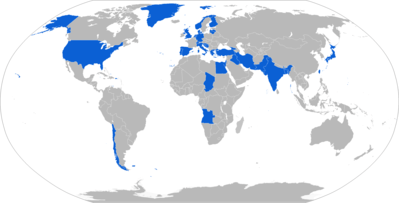
- Afghan Mujahideen
































See also
- 9K38 Igla (SA-18 "Grouse") – the Soviet Union's equivalent missile during the Cold War
- 9K333 Verba – a Russian-developed replacement for the 9K38 Igla
- AIM-92 Stinger
- Qaem
- Misagh-2
- Anza (missile)
- FN-6
- Grom – a man-portable air-defence system produced in Poland
- Mistral missile
- QW-1 Vanguard – the Chinese equivalent
- Starstreak – a British MANPADS
References
- John Pike. "FIM-92A Stinger Weapons System: RMP & Basic". globalsecurity.org. Archived from the original on 2010-07-09. Retrieved 2010-08-16.
- "General Dynamics / Raytheon FIM-92 Stinger - Development and Operational History, Performance Specifications and Picture Gallery". Archived from the original on 2016-09-14. Retrieved 2016-08-26.
- "General Dynamics / Raytheon FIM-92 Stinger – Man-Portable, Air Defense Missile System – History, Specs and Pictures – Military, Security and Civilian Guns and Equipment". militaryfactory.com. Archived from the original on 2014-02-02. Retrieved 2014-01-26.
- "US Army starts upgrade of FIM-92E Stinger Block I missiles - Army Technology". 2 November 2014. Archived from the original on 18 March 2017. Retrieved 17 March 2017.
- Osborn, Kris (6 November 2014). "Army Upgrades Stinger Missiles". Kitup.Military.com. Archived from the original on 25 September 2015. Retrieved 1 November 2015.
- Stinger upgrade to increase service life, capabilities Archived 2017-10-19 at the Wayback Machine - Army.mil, 29 October 2014
- This Stinger Missile Is Back Archived 2018-05-24 at the Wayback Machine. The National Interest. 18 May 2018.
- https://www.armyrecognition.com/united_states_american_missile_system_vehicle_uk/stinger_fim-92_fim-92a_man_portable_air_defense_missile_system_manpads_technical_data_sheet_picture.html
- Services, United States Congress Senate Committee on Armed (April 10, 1980). "Department of Defense Authorization for Appropriations for Fiscal Year 1981: Hearings Before the Committee on Armed Services, United States Senate, Ninety-sixth Congress, Second Session, on S. 2294 ..." U.S. Government Printing Office – via Google Books.
- "Technical Reports Awareness Circular : TRAC". Defense Technical Information Center. March 10, 1989 – via Google Books.
- "Britain's Small Wars". Facebook. Archived from the original on 2009-11-07.
- "San Carlos Air Battles - Falklands War 1982". naval-history.net. Archived from the original on 2011-06-03. Retrieved 2006-04-06.
- "Argentine Puma shot down by american "Stinger" missile. — MercoPress". MercoPress. Archived from the original on 2012-03-28. Retrieved 2009-11-07.
- Charlie Wilson's War: The Extraordinary Story of the Largest Covert Operation in History, George Crile, 2003, Grove/Atlantic.
- Military engineer recounts role in Soviet-Afghan war Archived 2012-07-10 at the Wayback Machine, By Michael Gisick, Stars and Stripes, Published: September 11, 2008
- "Successful surface-to-air missile attack shows threat to airliners". HomeLand1. Archived from the original on 2013-01-18. Retrieved 2012-12-28.
- Malley, William (2002) The Afghanistan wars. Palgrave Macmillan, p. 80. ISBN 0-333-80290-X
- Hilali, A. Z. (2005). US-Pakistan relationship: Soviet invasion of Afghanistan. p. 169. ISBN 0-7546-4220-8
- Alan J. Kuperman (1999). "The Stinger missile and U.S. intervention in Afghanistan" (PDF). Political Science Quarterly. 114 (Summer 1999): 219–263. doi:10.2307/2657738. JSTOR 2657738. Archived (PDF) from the original on 2014-10-21. Retrieved 2014-10-21.
- Robert F. Baumann "Compound War Case Study: The Soviets in Afghanistan". In Compound warfare: That fatal knot Archived 2015-09-23 at the Wayback Machine Thomas M. Huber (ed.) U.S. Army Command and General Staff College Press, Fort Leavenworth, Kansas. pg 296
- John Pike. "COMPOUND WAR CASE STUDY: THE SOVIETS IN AFGHANISTAN". globalsecurity.org. Archived from the original on 2012-01-19. Retrieved 2011-11-05.
- Yossef Bodansky. "SAMs in Afghanistan: assessing the impact." Archived 2016-12-06 at the Wayback Machine Jane's Defence Weekly, vol. 8, no. 03, 1987 PP. 153-154
- Cushman Jr, John H. (17 January 1988). "THE WORLD: The Stinger Missile; HELPING TO CHANGE THE COURSE OF A WAR". The New York Times. Archived from the original on 28 December 2016. Retrieved 7 February 2017.
- Scott, Peter (2003). Drugs, oil, and war: the United States in Afghanistan, Colombia, and Indochina. Rowman & Littlefield, p. 5. ISBN 0-7425-2522-8
- Blair Case, Lisa B. Henry. "Air Defense Artillery Yearbook 1993" (PDF). US Army Air Defense Artillery Branch. p. 20. Archived from the original (PDF) on 2013-04-25.
- Hammerich, Helmut (2010). Die Grenzen des Militärischen. Berlin: Hartmann, Miles-Verl. p. 195. ISBN 9783937885308.
- A conversation with Charlie Wilson Archived 2012-03-04 at the Wayback Machine, Charlie Rose, PBS, April 24, 2008, via charlierose.com
- Charlie Did It Archived 2012-10-03 at the Wayback Machine, CBS News, 60 minutes. December 19, 2007 9:51 AM, From March 13, 2001: Former Rep. Charlie Wilson looks back on his efforts to arm the Mujahedeen against the Soviet Union back in the 1980s. Mike Wallace reports.
- Kuperman, Alan J. (January–February 2002). "Stinging Rebukes". Foreign Affairs. Archived from the original on 20 July 2015. Retrieved 16 July 2015.
- Steele, Jonathan (2010). "Afghan Ghosts: American Myths". World Affairs Journal. Archived from the original on 17 July 2015. Retrieved 16 July 2015.
- "Afghanistan PSYOP Leaflet". psywarrior.com. Archived from the original on 2013-09-02. Retrieved 2013-07-07.
- Weiner, Tim (24 July 1993). "U.S. Increases Fund To Outbid Terrorists For Afghan Missiles". The New York Times. Archived from the original on 4 November 2012. Retrieved 2008-01-01.
- Stinger missile system Archived 2007-09-27 at the Wayback Machine
- Matthew Schroeder (July 28, 2010). "Stop Panicking About the Stingers". Foreign Policy. Archived from the original on August 2, 2017. Retrieved August 2, 2017.
- "Middle East brief (deleted) for 2 August 1988: In brief: x—Qatar" (PDF). Central Intelligence Agency. 1988-08-02. p. 3. Archived from the original (PDF) on 23 March 2012. Retrieved 2010-11-14.
- "Trade Registers". Armstrade.sipri.org. Archived from the original on 2011-05-13. Retrieved 2013-06-20.
- Silverstein, Ken (3 October 2001). "Stingers, Stingers, Who's Got the Stingers?". Slate. Archived from the original on 31 January 2011. Retrieved 1 November 2015.
- "Improvised MANPADS batteries employed in Syria | Armament Research Services". armamentresearch.com. Archived from the original on 2016-07-25. Retrieved 2016-08-05.
- Arnaud Delalande, The Ghost Plane of Faya-Largeau Archived 2018-01-10 at the Wayback Machine, 9 January 2018.
- "Welcome to the Air Combat Information Group". Archived from the original on 2013-08-21. Retrieved 2011-11-05.
- John Pike. "Uzbekistan- Air Force". globalsecurity.org. Archived from the original on 2014-10-19. Retrieved 2014-10-19.
- Human Rights in Tajikistan: In the Wake of Civil War By Escrito por Rachel Denber, Barnett R. Rubin, Jeri Laber. Google Books.
- "Militaryphotos.net". www.militaryphotos.net. Archived from the original on 2017-03-14. Retrieved 2016-08-05.
- Pashin, Alexander. "Russian Army Operations and Weaponry During Second Military Campaign in Chechnya". Moscow Defense Brief. Archived from the original on January 29, 2009. Retrieved 8 March 2014.
- Harro Ranter. "ASN Aircraft accident 10-NOV-1997 Mil Mi-24 CH619". aviation-safety.net. Archived from the original on 2015-05-07. Retrieved 2013-07-07.
- "FIM-92A Stinger Weapons System: RMP & Basic". Archived from the original on 2016-01-14. Retrieved 2016-01-01.
- Stephen Labaton (September 13, 1994). "Crash at the White House: The defenses; Pilot's Exploit Rattles White House Officials". The New York Times. Archived from the original on July 13, 2009. Retrieved 2008-09-08.
- "Syrian Rebels Claim to Have Brought Down a Jet". The New York Times. 13 August 2012. Archived from the original on 16 August 2012. Retrieved 13 August 2012.
- Trevithick, Joseph. "Turkey Strikes Back And Calls For No-Fly-Zone After Its Troops Die In Syria Airstrikes (Updated)". The Drive.
- Infodefensa.com (2015-09-23). "Colombia adquiere 60 misiles antiaéreos Stinger y 100 TOW antitanques - Noticias Infodefensa América" (in Spanish). Archived from the original on 2016-05-27. Retrieved 2016-08-05.
- "HS: Finland to splurge 90 million on US Stinger missiles". Yle Uutiset. Archived from the original on 2014-01-26. Retrieved 2014-01-26.
- Tiger Attack Helicopter, Europe. Archived 2008-10-24 at the Wayback Machine Retrieved on October 24, 2008.
- Times, Stephen Engelberg With Bernard E. Trainor, Special To The New York (1987-10-17). "Iranians Captured Stinger Missiles From Afghan Guerrillas, U.S. Says". The New York Times. ISSN 0362-4331. Archived from the original on 2016-12-28. Retrieved 2016-08-05.
- "Pak general says Iran stole Stinger missiles". iran-times.com. Archived from the original on 2015-07-17. Retrieved 2015-07-16.
- Datta, S. K. (12 June 2014). Inside ISI: The Story and Involvement of the ISI, Afghan Jihad, Taliban, Al-Qaeda, 9/11, Osama Bin Laden, 26/11 and the Future of Al-Qaeda~. Vij Books India Pvt Ltd. ISBN 9789382652595. Archived from the original on 9 April 2018. Retrieved 5 December 2017 – via Google Books.
- "Stingers for South Korea AH-64E Apaches". Archived from the original on 2016-08-12. Retrieved 2016-08-05.
- US Department of Defense. "Stinger" (PDF). North Korea Country Handbook 1997, Appendix A: Equipment Recognition. p. A-70. Archived (PDF) from the original on 2016-03-04. Retrieved 2018-09-05.
- "Archived copy" (PDF). Archived (PDF) from the original on 2018-08-21. Retrieved 2018-09-17.CS1 maint: archived copy as title (link)
- Tomkins, Richard (23 August 2017). "Latvia buying Stinger air-defense missiles from Denmark". United Press International. Archived from the original on 24 August 2017. Retrieved 24 August 2017.
- "US State Dept. Approves $4.25 billion Apache helo sale to Morocco". 2019-11-20.
- Singh, R.S.N. (2005). Asian Strategic And Military Perspective. Lancer Publishers. p. 238. ISBN 9788170622451.
- Sumit Ganguly & S. Paul Kapur (2008). Nuclear Proliferation in South Asia: Crisis Behaviour and the Bomb. Routledge. p. 174. ISBN 978-0-203-89286-2.
- "defpro.com". www.defpro.com. Archived from the original on 2015-10-24. Retrieved 2016-08-05.
- Official Roketsan Stinger Page. Archived 2009-01-01 at the Wayback Machine Retrieved on October 23, 2008.
Further reading
- O'Halloran, James C., and Christopher F. Foss (eds.)(2005). Jane's Land-Based Air Defence 2005–2006. Couldson, Surrey: Jane's Information Group. ISBN 0-7106-2697-5.
External links
| Wikimedia Commons has media related to FIM-92 Stinger. |